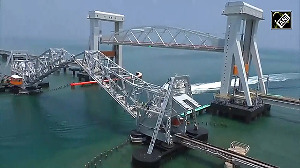India-Africa trade is booming. From $ 1 billion in 2001, the bilateral trade between India and the African Union countries has gone up to $ 40 billion in 2010. Indian investments in African countries are of the value of $ 50 billion.
Africa is on the rise; the economies of several African countries show a healthy rate of growth. Africa has an abundance of natural resources and minerals like cobalt, gold, chromium and manganese that provide new economic opportunities.
Mahindra vehicles and Tata buses ply on African roads, Bajaj motorcycles are a favourite ride for young Africans, and pharmacies carry Indian generic drugs while the small shops stock Indian products like soap and cosmetics. Major Indian enterprises such as the Tatas, Kirloskars, Dr Reddy's, NIIT have been in Africa for many decades and public sector companies like ONGC Videsh, BHEL, Coal India have made large investments in some African countries. The recent Indian forays have included big-ticket ventures like the $ 10.7 billion Bharti Airtel-Zion deal which have made Bharti Airtel's red and white colours a familiar sight on the African skyline.
Indian companies are sourcing products and commodities from Africa from cashew and pulses (tuar dal) to timber, coal (for thermal power plants) to crude oil. The government in Malawi is encouraging farmers to grow pulses to meet the demand in India. Indian floriculturists are growing flowers in African countries for export to European markets.
As the Indian engagement with Africa increases, there are inevitable comparisons with China's presence in Africa. Prime Minister Dr Manmohan Singh was asked about China's prominent presence in Africa during a recent press conference, and he had responded that the world was large enough to accommodate the growth ambitions of both India and China.
In the build up to the summit, a visiting African journalist recently asked top Indian officials in New Delhi why India's involvement with Africa was "low-key" as the African participation at the forthcoming summit was limited to 15 countries. The question coming in the run-up to the second Africa-India Forum Summit is a reality check on how India is perceived in Africa.
The Africa-India Forum Summit does not have the grand feel of a full summit of the 54-member African Union, but the decision to limit the African representation was taken by the African Union according to its Banjul formula.
India has a more important stake as a neighbouring region and has chosen to consult the African countries over their developmental needs and plan its assistance programs based on their recommendations. Since major decisions require lengthy consultations, decision-making is slow. It took almost two years to decide on a Joint Plan of Action. But India's consultative approach has drawn praise from African leaders. Chairman of the African Union Commission, Jean Ping described India's model as "the most unique and preferred of Africa's partnerships."
China, with the early thrust of its Africa policy, is seen a front-runner in Africa. China began its Africa policy in the early 1990s; it organized a grand summit of all the African countries -- the Forum for China-Africa Cooperation in 2000. It holds regular ministerial meetings with the African Union. With its huge resources and focused approach China has a highly visible presence and India was viewed as the laggard. China tied up the major contracts for oil exploration and mining; it has taken up major aid programmes and construction projects, building flashy new airport terminals and presidential palaces.
India's engagement has had a different trajectory. During the decolonisation period and later in the struggle against apartheid, there was a close relationship between Indian and African leaders. However, ties with Africa floundered during the 1990s when Indian priorities were affected by the changing global equations of the post- Cold War era. A new Africa policy was initiated in the next decade, a Focus Africa initiative was launched in 2002 but that was concentrated mainly on the east African region. In 2004 India reached out to nine west African countries with Team-9 or the Techno Economic Approach for Africa India Movement.
The Africa focus gained strength only after India began a high level structured interaction with the African Union through the first India-Africa Forum Summit that was held in New Delhi in 2008. It was a successful and productive summit which authored a document called 'the Framework of Cooperation' that spelt out areas for cooperation. India offered a $ 5.4 billion line of credit for the African countries to be spread over a period of five years.
Indian projects are mainly developmental projects and people-centric programmes that do not have a high visibility but help to build goodwill in the country. The Indian Pan-African e-Network has connected the countries of the African Union providing digital connectivity between member countries and premier Indian institutes for the purpose of tele-education and tele-medicine.
Indian assistance in capacity building in human resources is focused on upgrading skills and knowledge of trainers. About 450 African trainers attended special training courses in different fields in the past three months in top Indian institutes. The training modules ranged from tackling cyber crime to disaster management to dispute resolution. "The pattern of training the trainers was chosen because of its multiplier effect as the trainers would return to their own institutes and teach the newly learnt skills to their students," an Indian official explained.
It is not just China, but Japan and the European countries which are showing greater interest in the new opportunities in Africa. India's interaction with Africa is growing at a fast pace, the second Forum Summit will set a new agenda but it is the India Inc that is likely to be the driving force in the India-Africa engagement.










 © 2025
© 2025